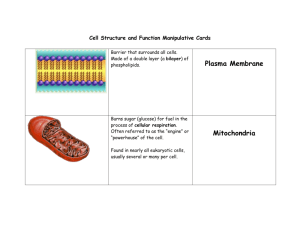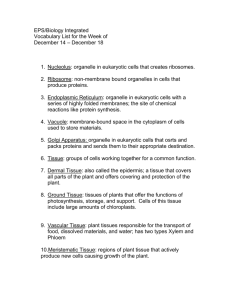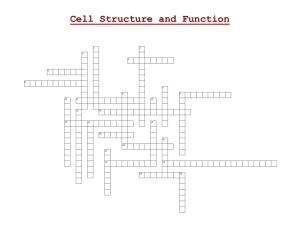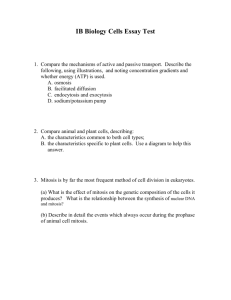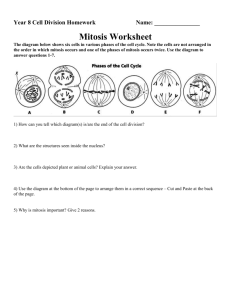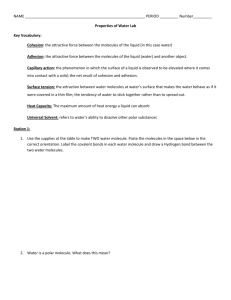Cell & Mitosis Qualifier
advertisement
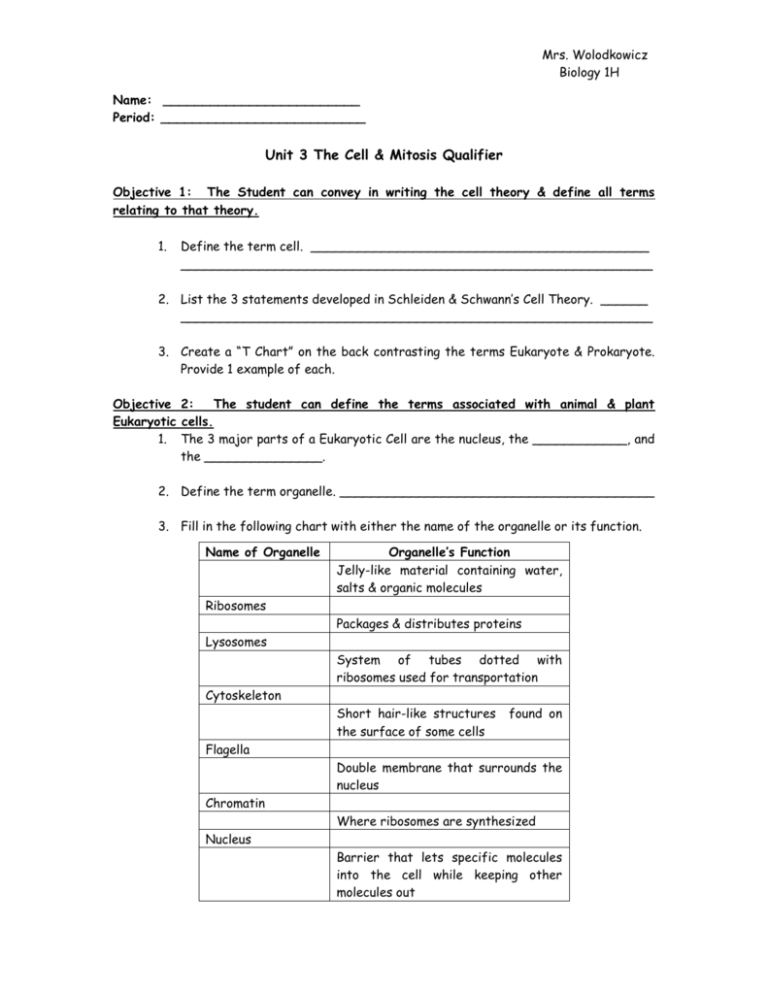
Mrs. Wolodkowicz Biology 1H Name: _________________________ Period: __________________________ Unit 3 The Cell & Mitosis Qualifier Objective 1: The Student can convey in writing the cell theory & define all terms relating to that theory. 1. Define the term cell. ___________________________________________ ____________________________________________________________ 2. List the 3 statements developed in Schleiden & Schwann’s Cell Theory. ______ ____________________________________________________________ 3. Create a “T Chart” on the back contrasting the terms Eukaryote & Prokaryote. Provide 1 example of each. Objective 2: The student can define the terms associated with animal & plant Eukaryotic cells. 1. The 3 major parts of a Eukaryotic Cell are the nucleus, the ____________, and the _______________. 2. Define the term organelle. ________________________________________ 3. Fill in the following chart with either the name of the organelle or its function. Name of Organelle Organelle’s Function Jelly-like material containing water, salts & organic molecules Ribosomes Packages & distributes proteins Lysosomes System of tubes dotted with ribosomes used for transportation Cytoskeleton Short hair-like structures the surface of some cells found on Flagella Double membrane that surrounds the nucleus Chromatin Where ribosomes are synthesized Nucleus Barrier that lets specific molecules into the cell while keeping other molecules out Mrs. Wolodkowicz Biology 1H 2 4. Three Eukaryotic cell parts found only within plant cells are plastids, ________, & cell wall. 5. Using the terms hydrophobic & hydrophilic, explain why we say the cell membrane is selectively (semi) permeable._____________________________ Objective 3: The student can apply their knowledge of passive transport to the following questions. 1. The movement of water across a semi-permeable membrane is known _______. 2. The movement of molecules from a high concentration to a low concentration is called ______________________________________________________. 3. Define the term facilitated diffusion & provide an example. _______________ 4. The ability of a solution to alter its tone/shape by changing its internal water volume is known as _____________________________________________. 5. Study the illustration below & identify what type of solution the cell has been placed in. This system is an animal cell placed inside a beaker that contains a water-based (aqueous) solution (dots represent solute). Beaker A cell ∙ Name this type of solution _______________________________. 6. Noting that the cell in Beaker A is permeable to water but not to the solute, what will be the net movement of water in this system? ________________ 7. What will be the effect on the cell? ________________________. Mrs. Wolodkowicz Biology 1H 3 8. Study the illustration below and identify what type of solution the cell has been placed in. This system is an animal cell placed inside a beaker that contains a water-based (aqueous) solution (dots represent solute). Beaker B cell ∙ Name this type of solution_____________________________. 9. Noting that the cell in Beaker B is permeable to both water & the solute, what will be the net movement of water in the system? _____________________. 10. What will be the effect on the cell? _______________________________. Objective 4: transport. 1. The student can write the definitions of terms related to active Active transport is the movement of molecules from a _________concentration to a ____________concentration. 2. A scientific term for “cell eating” is __________________________. 3. Define the term exocytosis ______________________________. 4. Explain the function of the Na+/K+ pump & how it demonstrates active transport____________________________________________. Objective 5: questions. 1. The student can apply their knowledge of mitosis to the following Define the term mitosis _________________________________________. 2. Contrast the terms chromatin, chromatid, & chromosome._________________ ____________________________________________________________ ____________________________________________________________ 3. Define the term autosome. _______________________________________ 4. Define the term Cytokinesis_______________________________________ Mrs. Wolodkowicz Biology 1H 4 5. In which 2 organs does mitosis no longer occur? _______________________ 6. List the three events that occur during Interphase. Briefly explain what occurs during these events. ____________________________________________ ____________________________________________________________ ____________________________________________________________ ____________________________________________________________ 7. Discuss the phases of mitosis from Prophase to Telophase. Include drawings of each.
